ISSN ONLINE(2319-8753)PRINT(2347-6710)
ISSN ONLINE(2319-8753)PRINT(2347-6710)
P. B. Jadhav,*, R. T. Thokal, M.S. Mane, H.N. Bhange and S.R.Kale
|
| Related article at Pubmed, Scholar Google |
Visit for more related articles at International Journal of Innovative Research in Science, Engineering and Technology
Conveyance losses from lined and unlined sections of canal irrigation network were determined under existing situation and the scenarios for different management strategy were developed to utilize saved water for irrigation in Panchnadi Minor Irrigation Project. The overall efficiency and total loss from the lined, unlined section of canal and unlined field channel under existing condition was obtained as 75, 52 and 35 per cent and 0.184, 0.61 and 0.183 Mm3 respectively. These results revealed that management interventions of converting the unlined canal network sections into lined sections can improve conveyance efficiency up to 75% and 0.376 Mm3 of water can be saved from which about 43 ha additional area can be irrigated. The intervention of micro-irrigation systems can lead to 24.42 to 235.54 per cent by adoption of drip irrigation from 10% to 100% and project net benefit was found to increase to Rs.10.41 lakh and Rs.13.17 lakh over 10.03 lakh with 0.99 and 9.8 ha additional area can be brought under irrigation respectively.
Keywords |
| WUE, CWP, Management Interventions, Gross water allocation |
INTRODUCTION |
| Water conveyance loss consists mainly of operation losses, evaporation and seepage into the soil from the sloping surfaces and bed of the canal. The most important of these is seepage. Evaporation loss in irrigation networks is generally not taken into consideration [19, 5]. The seepage loss in the irrigation canals accounts for the major portion of water conveyance loss (98.37%) while approximately 0.3 per cent of the total stream is lost due to evaporation [17]. The lining of an irrigation canal has the advantages of reduction in seepage losses from canals reaching water table and raising it resulting in waterlogging and reduction in yield, reduction in losses thereby making more water available for extension of irrigation to new areas and improvement of irrigation facilities in the areas already under irrigation. Micro irrigation is frequent application of small quantities of water as drops, tiny streams, or miniature spray through emitters or applicators placed along a water delivery line. It is generally perceived that adoption of micro irrigation system in command area leads to increase in yield, real water saving and expansion in area under irrigation, all resulting in social benefits [18]. It was found that 6 per cent increase in net benefit could be achieved through reutilization of the micro irrigation systems among the seasonal crops having similar system requirements in canal command area [25]. |
MATERIAL AND METHODS |
| A. Study area |
| The study area selected is the command area of Panchnadi Minor Irrigation Project, which is located on Panchnadi river Dapoli tehsil of Ratnagiri district, Maharashtra state (India). The location map of Panchnadi Minor Irrigation Project is shown in Fig. 1. |
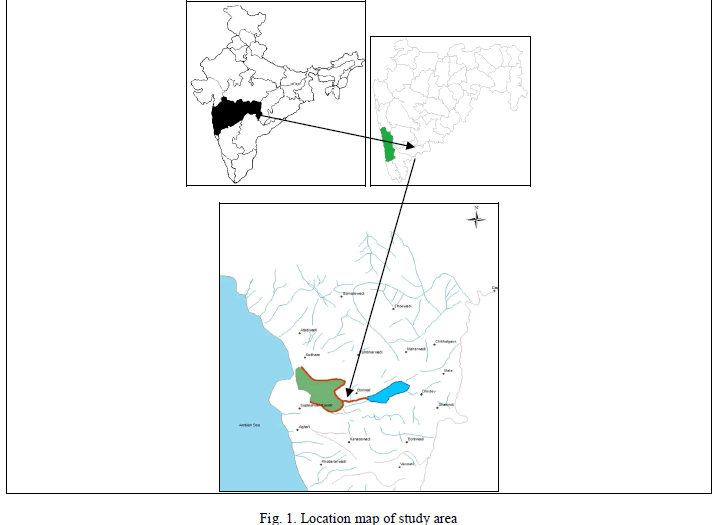 |
| B. Details of the project |
| The dam is earthen with masonary spillway. The dam site is located between 730 10’ E longitude and 170 37’ N latitude. The total length and height of dam is 180 m and 24.92 m respectively. The maximum flood level is 110.837 m, and storage level is 108 m. The possible total storage, active or live storage and dead storage of dam are 1.738 Mm3, 1.461 Mm3 and 0.277 Mm3 respectively. |
| C. Measurement of Conveyance losses |
| 1 Conveyance losses in reservoir |
| The losses in reservoir comprises evaporation and percolation losses, which is assumed as 10 per cent of the live storage of the reservoir i.e. 0.146 Mm3 according to geotechnical report of Panchnadi minor irrigation project [6]. |
| 2 Conveyance losses in canal network |
| 2.1 Measurement of seepage losses through canal network |
| The seepage loss through canal network was calculated by measuring the difference between the discharges at two points in the canal section. The dimensions of canal section and field channel were measured by measuring tape. Current meter was used for measuring the flow velocity (cm/s) at two points. |
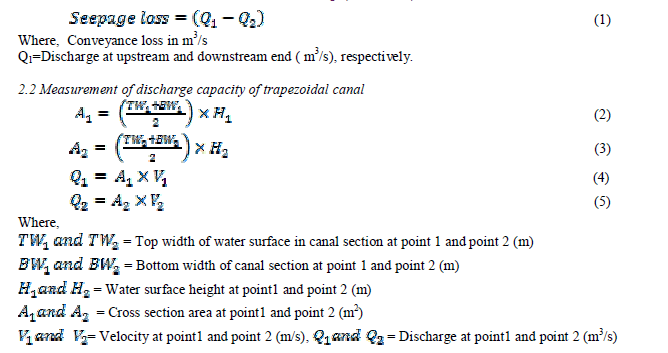 |
| 2.3 Calculation of evaporation losses |
| Evaporation loss depends on the evaporative demand of the atmosphere and calculated as, |
| E (m3/day) = Surface area exposed for evaporation (m2) x Evaporation rate (m/day) (6) |
| Surface area exposed for evaporation (m2) = Top width of canal (m) x Length of canal (m) (7) |
| 2.4 Measurement of conveyance loss |
| The loss of water due to seepage and evaporation from irrigation canals constitutes a substantial part of the usable water. By the time the water reaches the field, more than half of the water supplied at the head of the canal is lost in seepage and evaporation. Thus, care must be taken in the design of such canals to account for evaporative losses along with seepage loss. |
| The conveyance loss per meter of canal network is calculated by dividing total conveyance loss by respective length of canal network. |
| 2.5 Water conveyance efficiency |
| Water is conveyed through canal network, watercourses and channels from sources such as reservoirs, rivers and dams to fields or farms for crop use. Conveyance efficiency is used to evaluate the efficiency of the system conveying water. It is also used to measure the efficiency of channels conveying water from wells and ponds to fields. Water conveyance efficiency may be defined as the percentage ratio of the amount of water delivered to fields or farms to the amount of water diverted from sources. |
| D. Application of management interventions |
| 1. Increasing conveyance efficiency through canal lining |
| The conveyance efficiency in the unlined irrigation system, which is about 56 per cent, can be increased to 88 per cent, when the whole system is lined. Therefore there is considerable scope of improving the efficiency of water use by lining the system [7]. |
| 2. Adoption of micro irrigation |
| Micro-irrigation is introduced primarily to save water and increase the water use efficiency in agriculture. However, it also delivers many other economic and social benefits to the society. Reduction in water consumption due to drip method of irrigation over the surface method of irrigation varies from 30 to 70 percent for different crops [15, 3, 30]. According to data available from research stations, productivity gain due to use of micro-irrigation is estimated to be in the range of 20 to 90 per cent for different crops [15]. While increasing the productivity of crops significantly, it also reduces weed problems, soil erosion and cost of cultivation substantially, especially in labor-intensive operations. |
| 3. Scenario development for management interventions and cropping pattern |
| The new cropping patterns were suggested by irrigating the extra area from remaining water in the storage due to application of management interventions. The extra area was divided into three crops which were highest beneficial for that region. The total benefit was calculated as addition of net project benefit of existing cropping pattern and additional suggested cropping pattern. |
RESULTS AND DISCUSSION |
| The main canal is lined for 1.33 km and remaining length (0.67 km) is unlined. The whole length (0.29 km) of field channel is unlined. The losses from the canal network under existing condition are presented in TABLE I to TABLE III. |
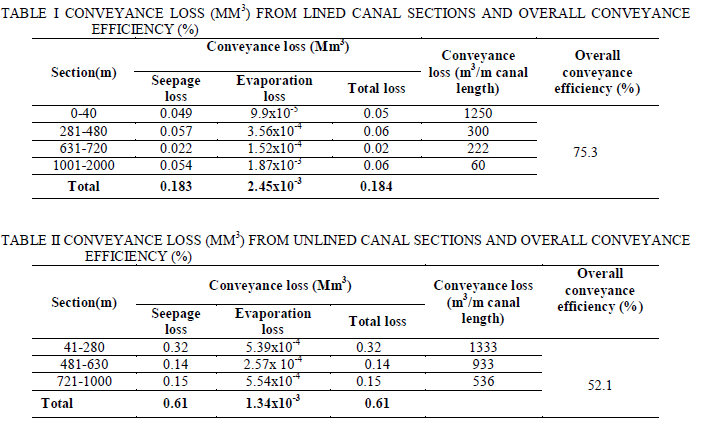 |
 |
| From the above results, the overall conveyance efficiency of the lined, unlined section of the main canal and field channel was observed as 75, 52 and 34 per cent respectively. Conveyance losses from unlined canal and field channels have contributed to more losses. Water flows in the canal runs from 1st October to 31st May i.e. 243 days. The loss (m3/m canal length) from first lined and unlined canal section was highest than the remaining sections. As discharge decreases the rate of water loss per meter of canal length in lined and unlined sections goes on decreasing. The conveyance loss (m3/m canal length) of first unlined section of canal was 6.6 per cent more than first lined section, while this loss was 3 times more in second section. In case of the third section the loss was 2.4 times more in unlined section than lined section of canal. The conveyance loss (m3/m channel length) in field channel was highest in first channel followed by 3rd, 4th, 2nd and 5th section of channel. In lined, unlined main canal sections and field channels, the evaporation loss was 1.32 per cent, 0.22 per cent and 0.045 per cent of total loss. The evaporation losses in lined canal were observed to be more than the unlined section because the length of lined section is about 2 times that of the unlined section. The total loss from lined, unlined main canal sections and unlined field channels was observed as 0.184, 0.61 and 0.183 Mm3, respectively. |
| 3.1 Management strategies |
| The results in previous section indicate that the net water requirement for crops in command area is 0.31 Mm3 while gross water requirement is 1.43 Mm3. This indicates that overall efficiency of the project is about 22 per cent. It is also seen that the major losses (0.97 Mm3) through the canal network works out to 67 per cent of the total live storage. These results emphasize that there is a need of management intervention through either converting the unlined canal network sections into lined sections or replacing the existing canal network with a pipeline. The scenarios were developed for these aspects and discussed below. |
| 3.1.1 Improving conveyance efficiency through lining of unlined sections of canal network |
| The results of conveyance losses in the canal network explained in the previous section indicated that the conveyance efficiency of unlined main canal sections having the total length 0.67 km is 52 per cent. Also for the unlined field channels the conveyance efficiency is very poor (34 per cent) thus the results indicated that there is scope to improve the conveyance efficiency of the canal network sections at least upto 75 per cent. Thus the scenarios were developed for these sections if unlined sections of the main canal are converted into the lined sections for the improved conveyance efficiency so as to quantify the water saving by reducing these losses. The probable water saving and predicted additional area that can be brought under irrigation after converting unlined sections of main canal and field channel into lined sections are given in TABLE IV and TABLE V respectively. |
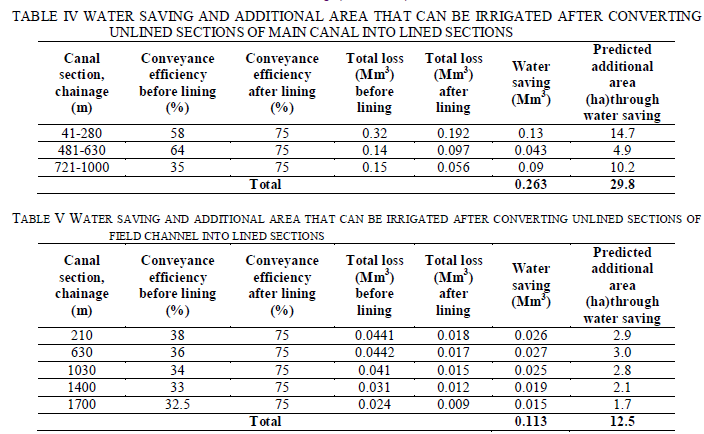 |
| The above results indicate that if the unlined sections of main canal are converted into lined sections then the 0.263 Mm3 of water can be saved from which about 30 ha additional area can be irrigated. If the unlined sections of field channels are converted into lined sections then the 0.113 Mm3 of water can be saved from which about 13 ha additional area can be irrigated. If both the unlined sections of canal network are converted into lined sections then the 0.376 Mm3 of water can be saved from which about 43 ha additional area can be irrigated through improving conveyance efficiency up to 75 per cent from the present efficiency. |
| 3.1.3 Scenario for Adoption of drip irrigation |
| Surface irrigation needs more water compared to micro irrigation and leads to water accumulation of excess water in absence of proper drainage arrangement. It is admitted fact that the yields of crops are higher under micro irrigation system. It also leads to substantial saving of water. Generally, in drip irrigation, water saving ranges from 5 to 68 per cent and yield increase of the crops is in the range of 10 to 50 per cent. Though, operation and maintenance cost for energy charges of this system is more when compared to surface irrigation, it is more efficient with regard to the water use efficiency. Irrigation efficiency in drip irrigation is about 90 per cent when compared to 35-50 per cent in case of lined distribution of conventional method of irrigation as per the CWC studies [28]. In addition to water saving, micro irrigation also results in enhanced yield of crop with superior quality, saving in labour and energy, flexibility in operation etc. In this study the scenario for adoption of drip irrigation was also developed for the different percentage of adoption. The scenarios were developed only for seasonal and annual crops. Variation in soil water depletion in root zone (Dr) of cucumber over growing period (days) at 90mm water application by surface irrigation and at 70 mm application by drip irrigation is given in Fig.2(a) and Fig. 2(b). The moisture stress in cucumber (Fig. 2(a)) was found in 90 mm water application by surface irrigation during period of 75-85 and 95-105 days of flowering and developing stage means the moisture content was reached below soil water thresholds triggering early canopy development (Th3) which may result in reduction of yield as compared to that of the full irrigation. In case of 70 mm water application by drip irrigation (Fig. 2(b)) the moisture content in the root zone for whole growing period was above Th3 and approximately at soil water thresholds inducing stomata closure (Th2) from 90-115 days. The moisture content does not drop down due to the frequent application of water by drip irrigation which results in increase in yield of cucumber by 30 per cent with 20 per cent water saving over 90 mm water application by surface irrigation. Han et al. [14] showed that the water production function of cucumber was closely related to its yield and water requirement by cucumber at its early growth stages was closely associated with yield. Predicted crop yields through surface and drip irrigation methods and comparison of yields with respect to deficit irrigation is given in TABLE VI. From the results of the TABLE VI with the 10 per cent deficit, the yield increases in drip irrigation over surface irrigation valid from 0.5 to 47 per cent with highest per cent in cucumber and lowest in brinjal. With 30 per cent deficit, the variation in yield of drip over surface was from 5.28 per cent in groundnut to 91.08 per cent in cucumber. With 50 per cent deficit this variation ranges from 9.93 per cent in beans to 48.11 per cent in cucumber. |
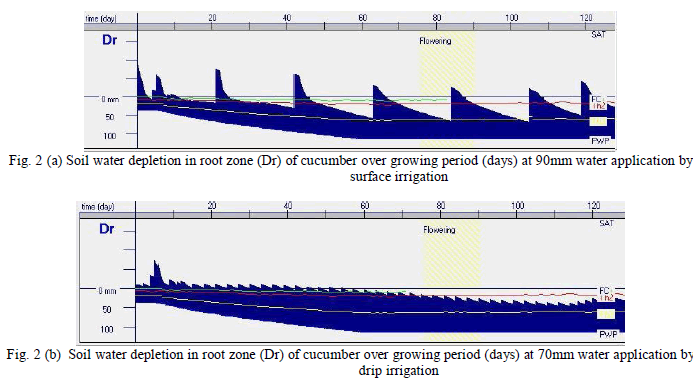 |
| Comparison of yield in drip irrigation system with 30 per cent deficit and crop yield in surface irrigation system with 10 per cent deficit irrigation indicated that most of the crops yielded more than the yield in drip irrigation with 30 per cent deficit as compared to that in surface with 10 per cent deficit. This indicated that the crop yields can be enhanced through drip irrigation system with at least 20 per cent water saving. It was seen that crops like banana, groundnut and beans yielded approximately equivalent yield for 30 per cent deficit in drip irrigation compared to 10 per cent deficit in surface irrigation. Thus it can be concluded that, the water saving can be achieved up to 40 per cent through drip irrigation without causing the reduction in yield as compared to surface irrigation system. The scenarios were also developed for the project net benefit and water saving in case of the various percentage of adoption of drip irrigation for seasonal and annual crops for the existing cropping pattern. The project net benefit and per cent water saving in case of adoption of drip irrigation with various percentages are given in Fig. 3. |
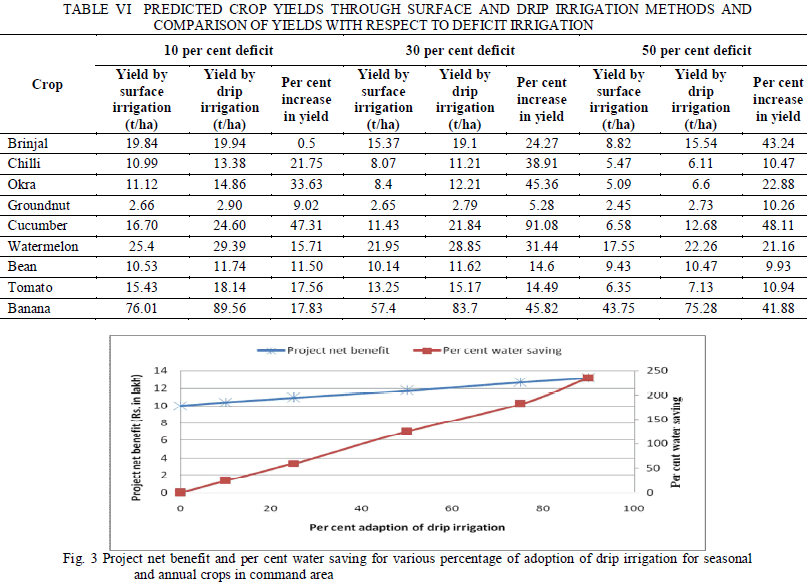 |
| From the Fig. 3 it is seen that in case the drip irrigation system is adopted on 10 per cent area of seasonal and annual crops (1.7 ha) out of present scenario of 100 per cent (17 ha) under traditional irrigation method, the water saving was (24.42 per cent) and project net benefit increased to Rs.10.41 lakh over 10.03 lakh. Similarly, if the drip irrigation system is adopted for 90 per cent area of seasonal and annual crops (15.3 ha) out of present scenario of 100 per cent (17 ha) under traditional irrigation method, the water saving was (235.54 per cent) and project net benefit increased to Rs.13.17 lakh over 10.03 lakh. In other words with the saving of 24.42 per cent of water by adapting drip irrigation on 10 per cent area, 0.99 ha additional area can be brought under irrigation. Similarly, with the saving of 235.54 per cent of water by adapting drip irrigation on 90 per cent area, 9.8 ha the additional area can be brought under irrigation. This indicates that when the drip irrigation system is adopted for 90 per cent area of the seasonal and annual crops in the command area, total 26.8 ha area can be irrigated over the present scenarios of 17 ha. |
| 3.2 Scenario for suggested cropping pattern |
| In case of present scenario the gross water required for 10 per cent deficit strategy was 1.43 Mm3; the live storage is 1.46 Mm3. It is also seen that under the present conditions the losses for canal network are 3.6 times than net irrigation requirement. These losses are reduced by increasing conveyance efficiency by lining of unlined sections of canal network and field channels. The results (TABLE IV and V) indicate that 0.263 Mm3 and 0.113 Mm3 of water can be saved if the unlined canal sections and field channels are converted into lined sections. These per cent savings 43 ha additional area can be irrigated through lining conversion. The scenarios were developed by considering the area distributed among the first three highest benefiting crops. These modifications are referred as suggested cropping pattern in this case. The total benefit from additional area after conversion and replacement of unlined sections and whole canal network into lined section is given in TABLE VII and the total project benefit by combination of benefit from additional area with existing benefit is given in TABLE VIII. |
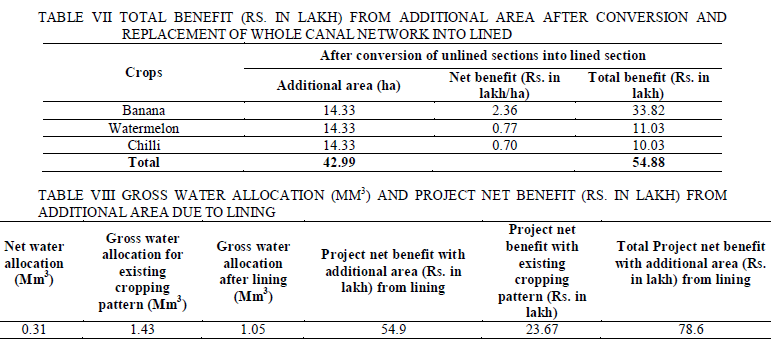 |
| The gross water allocation was reduced about 26 per cent while the project net benefit was increased by 3.3 times more over the existing conditions when unlined canal sections and field channels is converted into lined sections. |
CONCLUSION |
| If the unlined sections of main canal are converted into lined sections then the 0.263 Mm3 of water can be saved and from which about 30 ha additional area can be irrigated. If the unlined sections of field channels are converted into lined sections then the 0.113 Mm3 of water can be saved from which about 13 ha additional area can be irrigated. If both the unlined sections of canal network are converted into lined sections then the 0.376 Mm3 of water can be saved from which about 43 ha additional area can be irrigated through improving conveyance efficiency up to 75 per cent from the present efficiency. It was seen that in crops like banana, groundnut and beans there was approximately equivalent yield for 30 per cent deficit in drip irrigation compared to 10 per cent deficit in surface irrigation. Thus it can be concluded that, the water saving can be achieved up to 40 per cent through drip irrigation without causing the reduction in yield as compared to surface irrigation system. The drip irrigation system is adopted in 10 per cent area of seasonal and annual crops (1.7 ha) out of present scenario of 100 per cent (17 ha) under traditional irrigation method, the water saving was (24.42 per cent) and project net benefit increased to Rs.10.41lakh over 10.03 lakh. Similarly, if the drip irrigation system is adopted for 90 per cent area of seasonal and annual crops (15.3 ha) out of present scenario of 100 per cent (17 ha) under traditional irrigation method, the water saving was (235.54 per cent) and project net benefit increased to Rs.13.17 lakh over 10.03 lakh. The gross water allocation was reduced about 26 per cent while the project net benefit was increased by 3.3 times more than the existing conditions when unlined canal sections is converted into lined sections. |
References |
|